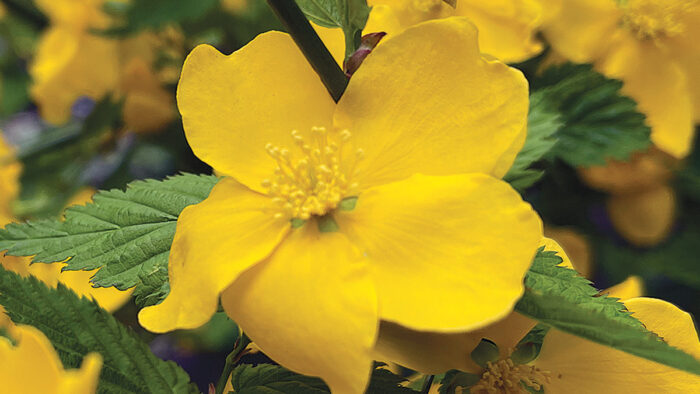
Finding interesting plants for shade can be a struggle, but when you add in the desire for that plant to be a woody shrub, the list narrows even more. But these structural wonders are essential in giving our shady beds and borders depth and real presence.
Whether you’re looking for colorful foliage, fabulous flowers, or out-of-this-world texture, there is sure to be at least one shade-loving shrub that will fit the bill. To help us hunt down these elusive garden treasures, we asked regional experts to pick out their four favorite shrubs for shade. Check out some sensational selections for the Northeast below, and discover even more shade-loving shrubs in this episode of the Let’s Argue About Plants podcast.
1. ‘Venus’ sweetshrub

Name: Calycanthus ‘Venus’
Zones: 5–9
Size: 7 to 12 feet tall and 10 to 15 feet wide
Conditions: Full sun to partial shade; rich, moist, loamy soil
Native range: Hybrid
This is a complex hybrid between two North American native species (C. florida and C. occidentalis), along with a species from western China (C. chinensis). A quick grower, ‘Venus’ will eventually form a large multistemmed shrub, so give it plenty of room, especially if it is grown as an understory plant under the high canopy of deciduous trees. It often stretches wider than it does tall, which sometimes surprises gardeners. One of the best reasons to plant ‘Venus’ is for its fruity-scented flowers, which smell like strawberry bubble gum to me. Expect most of the bright white blooms to appear in late May through mid-June. However, my plants tend to produce sporadic blossoms here and there throughout summer. The 10-inch leaves turn golden yellow in fall, adding to this shrub’s appeal. As a bonus, it is also tolerant of clay.
2. ‘Golden Guinea’ kerria

Name: Kerria japonica ‘Golden Guinea’
Zones: 4–9
Size: 5 to 8 feet tall and 6 to 10 feet wide
Conditions: Full sun to partial shade; average soil
Native range: Japan
I’ve had drivers stop and strangers walk through my yard just to ask me, “What’s that shrub blooming at the corner of your driveway?” ‘Golden Guinea’ kerria is just one of those plants that will earn lots of comments when it is in full flower. There is a double version of this fantastic shrub called ‘Flora Pleno’ (K. japonica ‘Flora Pleno’), which is perhaps just a bit too much of a good thing. ‘Golden Guinea’, on the other hand, hits the perfect tone: tasteful, and with single, bright yellow flowers that resemble single roses. To keep this quick-growing shrub looking tidy and elegant, each year remove one-third to one-half of the branches completely to the ground after blooming. Deer-resistant, it looks best when planted in informal settings such as the borders of a woodland or when added to a mixed bed with other shrubs.
3. Hobblebush

Name: Viburnum lantanoides
Zones: 3–7
Size: Up to 12 feet tall and 4 to 5 feet wide
Conditions: Partial shade; well-drained, average soil
Native range: Northeastern North America
As more of us are adding native shrubs and exploring more natural planting schemes, hobblebush is being revisited by gardeners, especially here in the Northeast. It is a viburnum, but it could be mistaken for a lacecap hydrangea when it is in bloom during May. Its simple appearance adds the perfect note to a woodland garden if you’re looking for a touch of authenticity. Hobblebush is often that missing note among maple trees (Acer spp. and cvs., Zones 3–9), ferns, and native shadblow (Amelanchier canadensis, Zones 4–8). The arching stems that touch the ground often develop roots that can trip or “hobble” a hiker—hence the common name. You’re just unlikely to find a hobblebush at your average garden center. Look for it at specialty nurseries, mailorder sources, or at wildflower centers.
4. Swamp azalea

Name: Rhododendron viscosum
Zones: 4–9
Size: 3 to 5 feet tall and wide
Conditions: Partial shade; acidic, moist, well-drained soil
Native range: Eastern and southern United States, the Atlantic coast of Canada
Whenever I find time to hike a mountain in Vermont or New Hampshire in early summer, I am seduced by this deciduous rhododendron, yet rarely have I thought about adding a few to my garden. But why not? Why wouldn’t I want that spicysweet scent that wafts from the white to palest pink blooms across the summer hiking trails? Now I am totally addicted to the idea of incorporating this useful, salt-tolerant, native species into my beds. There are some notable cultivars too, including ‘Delaware Blue’ (with bluish green leaves and stunning dark pink flowers) and ‘Betty Cummins’ (with candy pink, tubular flowers held in trusses). But in my opinion, the species remains hard to beat.
Matt Mattus is a regional reporter for FineGardening.com. The author of two gardening books, he gardens in Worcester, Massachusetts.
Fine Gardening Recommended Products

Black and Decker 22-inch Cordless Hedge Trimmer

DeWalt Variable-Speed Cordless Reciprocating Saw

DeWalt Variable-Speed Cordless Reciprocating Saw with 6-Piece Saw Blade Set


















Comments
Log in or create an account to post a comment.
Sign up Log in